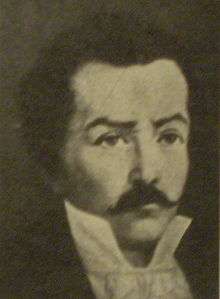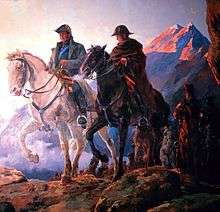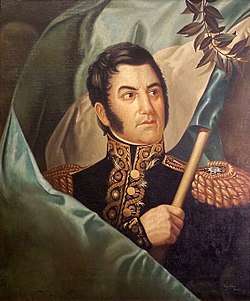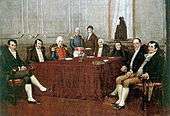Francisco Narciso de Laprida
Francisco Narciso de Laprida (October 28, 1786 in San Juan – September 22, 1829) [1] was an Argentine lawyer and politician. He was a representative for San Juan at the Congress of Tucumán, and its president on July 9, 1816, when the Declaration of Independence of Argentina was declared.[1]
Francisco Narciso de Laprida | |
|---|---|
 | |
| Born | October 28, 1786 |
| Died | September 22, 1829 Mendoza, Argentina |
| Occupation | Lawyer |
Biography
Laprida started his studies at the Real Colegio de San Carlos in Buenos Aires, after which he moved to Santiago de Chile to study Law at the Universidad de San Felipe, where he graduated in 1810. He participated in the Cabildo Abierto in Chile, one of the first steps towards the independence of that country. In 1812 he returned to San Juan, where he was named trustee of the Cabildo government house.
As such, Laprida collaborated with José de San Martín in the organization of the Ejército de los Andes. Because of his education in law and as an important local figure, he was sent to the Tucumán Congress in 1815 as provincial deputy, together with Fray Justo Santa María de Oro. As the congress had a rotating presidency, Laprida was selected for the presidency on July 1, and was still its president 8 days later, when the independence of the country was declared.
He returned to San Juan at the end of the deliberations, where he served as acting governor replacing José Ignacio de la Roza. As interim governor he took a determined and tough line against the dissidents. At the end of his internship he represented his province again in 1824 at the General Constituent Congress, being its president for some months.
Like many other nineteenth century Argentines prominent in public life, he was a freemason.[2]
As a member of the Unitarian Party, the execution of Manuel Dorrego by Juan Lavalle was a hard blow, after which Laprida returned to San Juan. He later had to flee again towards Mendoza Province, to escape Manuel Oribe and Facundo Quiroga's forces. On September 22, 1829, the men of José Félix Aldao, shortly after defeating the unitarian commander Juan Agustín Moyano, reached Laprida's coach and slit his throat; his body was never found.
He is also the great-great-great uncle of Argentine writer Jorge Luis Borges [3]
References
- Francisco Narciso de Laprida | La guía de Historia
- The list includes Juan Bautista Alberdi, Manuel Alberti, Carlos María de Alvear, Miguel de Azcuénaga, Antonio González de Balcarce, Manuel Belgrano, Antonio Luis Beruti, Juan José Castelli, Domingo French, Gregorio Aráoz de Lamadrid, Francisco Narciso de Laprida , Juan Larrea, Juan Lavalle, Vicente López y Planes, Bartolomé Mitre, Mariano Moreno, Juan José Paso, Carlos Pellegrini, Gervasio Antonio de Posadas, Domingo Faustino Sarmiento, and Justo José de Urquiza. José de San Martín is known to have been a member of the Lautaro Lodge; but whether the lodge was truly masonic has been debated: Denslow, William R. (1957). 10,000 Famous Freemasons. 1–4. Richmond, VA: Macoy Publishing & Masonic Supply Co Inc.
- Williamson, 2005: 17
- (in Spanish) Argentina Ministry of Education
- (in Spanish) La Guía 2000
- Williamson, E, 2005, Borges: A Life, Penguin Books, New York





